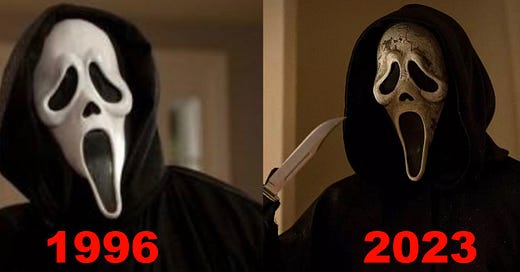What does Scream VI add to your life that Screams I-V didn't already give you?
“See a new-look Ghostface mask in exclusive Scream VI photo” declares Entertainment Weekly. Oh okay cool: The sixth feature film entry in a 30-year-old franchise is debuting a redesigned mask of its principle proto-villain. Sounds cool. What’s the “new-look Ghostface mask” that this movie offers nearly three decades after the first one debuted? Here’s the big reveal:
It’s nothing, in other words. It’s another Scream, another dollar-store mask, another guy behind the mask killing people. Hey, maybe it’s a woman this time? But wait they did that already, right? Wasn’t Julia Roberts’s niece the bad guy in one of these? So it’s all been done. There’s nothing new here, and so it is worth asking what, exactly, this movie will add to anyone’s life that the prior five movies have not already added. Why is it being made? Why has a film studio deployed tens of millions of dollars in product and talent to make a thing that is at best indistinguishable from the original and is essentially guaranteed to be much worse?
I am not sure of the answer to that. I don’t know what drives the decisions of studio executives. I guess it’s “money,” these movies are not that expensive to make and they’re usually good for a solid eight-figure profit, so I suppose that is the principle motivator. I guess the more relevant framing of the question is: Why are people still going to see these movies? Why is the sixth lame entry in an exhausted franchise such a sure bet for Paramount? Why would millions and millions of people ever drop $14 on a movie that is so obviously just a worse version of a movie they’ve already seen?
It might be hard to remember, being so many years ago, but the first Scream was something of a work of genius: Fresh, irreverent, clever, very funny, insightful and commentative on the nature of horror cinema itself. Famously the characters openly discussed amongst each other the “rules” of horror movies, with those “rules” eventually being demonstrated upon the characters themselves. Scream added something to the canon in a way other movies had not. The latest entries have clumsily struggled to do so in their own ham-fisted way; the fourth entry boldly declared: “New Decade. New Rules.” No, not really. The joke’s played out at this point. We’ve heard it before and it’s simply not funny anymore.
There is a broader issue at play here. The horror genre has of course always been derivative to some extent; the one or two decades preceding Scream had been marked largely by trash B-rolls and an endless string of lame, uninspired sequels to the great features of the 1970s and 1980s. Indeed, the original Scream was hailed as a break in that repetitiveness, a sort of reimagining of what horror could be and a revitalization of form. That the Scream series has un-ironically become the very kind of horror franchise it used to mock is perhaps the greatest meta-commentary of all.
But the bigger issue is that the entire film industry has become like this: Derivative, unimaginative, looking ever backward, terrified of chance and gamble and genuine creativity. Of the top 10 grossing films in the U.S. last year, literally every one of them was either (a) a stupid comic book movie, or (b) a sequel of some kind (in many cases both). In 2021, nine out of the 10 top films fit that description. In 2020 in the top rankings we had a comparatively fresh mix of (a) a stupid comic book movie, (b) three sequels, (c) the seventh adaptation of the 1868 novel Little Women, (d) the seventh movie about the 1920 character Dr. DoLittle, (e) the fourth major film adaptation of The Invisible Man, (f) the seventh adaptation of the 1903 book The Call of the Wild, (g) a Sonic the Hedgehog movie, and (h) one arguably original movie, Sam Mendes’s 1917.
Scream VI, in other words, is merely par for the course, just another listless entry in a denuded decades-old franchise as part of a cinematic landscape in an almost-total creative drought. Whenever I write stuff like this, movie nerds always rush to point out: “Good, original movies are still being made! You just have to look for them!” Sure, for the sake of argument, let us so stipulate. But most of us aren’t movie nerds; most of us don’t have the time or inclination to comb through Metacritic searching for favorable reviews and unheard-of directors. It used to be that two film economies could exist in tandem: Good, lower-budget, artistically distinctive small films that you kind of had to search for, and bigger-budget mainstream blockbuster movies that were also really good. The headline movies of U.S. cinema used to be of far more creative value and redemptive artistry than “Jumanji: The Next Level” and “Doctor Strange in the Multiverse of Madness.”
If your response to this permanent garbage lineup is to say, “You just have to go looking for the good movies!” then you’re kind of proving the point. There was a time when you didn’t have to do that; the good movies more or less came to you. Now the only thing that comes to you is Scream VI and its new Ghostface mask, and doubtlessly it will make $150 million in its first theatrical run. It’s not the movie landscape we need, but increasingly it’s the one we deserve.



